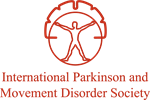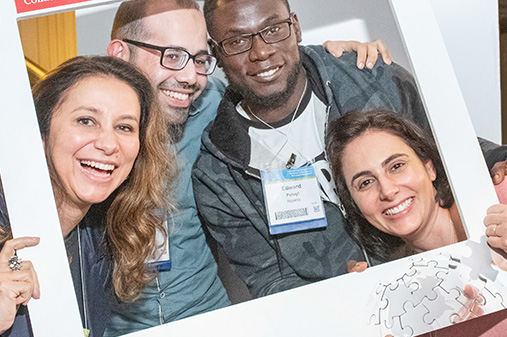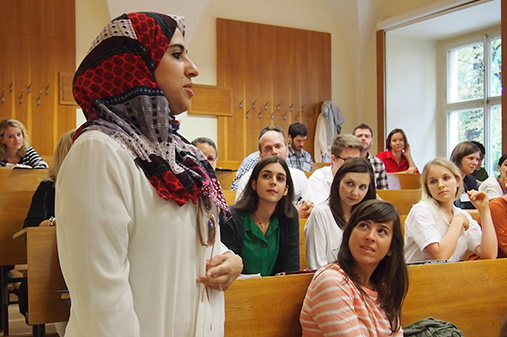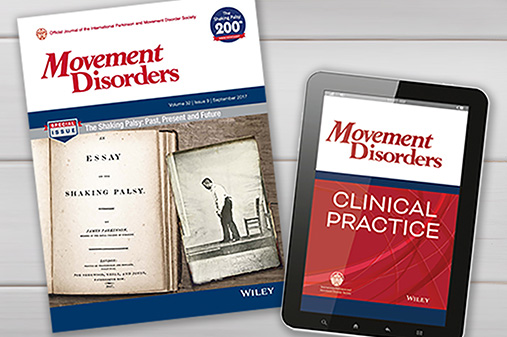Focused ultrasound for cervical dystonia
[00:00:05] Dr. Michele Matarazzo: Hello, and welcome to the MDS Podcast, the official podcast of the International Parkinson and Movement Disorder Society. I am Michele Matarazzo, and today we have a fascinating discussion lined up about the new approach for treating cervical dystonia using MR guided focused ultrasound palidothalamic tractotomy.
Our guest is Dr. Shiro Horisawa, a neurosurgeon from the Department of Neurosurgery of the Tokyo Women's Medical University in Japan, and the first author of a recently published pilot study on this topic. The title of the article is Focused Ultrasound pallidothalamic Tractotomy in Cervical Dystonia: a pilot study, and it was published on the Movement Disorder Journal in January 2025.
View complete transcript
Shiro, welcome to the podcast.
[00:00:49] Dr. Shiro Horisawa: Thank you for having me on the MDS podcast. I'm really honored to be here today to discuss our recent work. Thank you.
[00:00:57] Dr. Michele Matarazzo: A pleasure to have you. So let's dive into the [00:01:00] discussion. Let's start with some background. Cervical dystonia is a challenging condition to manage in many cases. Usually and traditionally we rely on botulinum toxin therapy. In some cases also with oral medication and for severe cases, deep brain stimulation is also an option.
Could you give us an overview of the limitation of this existing options and why there was a need for exploring new approaches?
[00:01:25] Dr. Shiro Horisawa: Yeah. Yeah. Usually a botulinum toxin injection are the first line treatment, even in Japan, but approximately 30 percent of the patients do not achieve the sufficient relief. For those for refractive botox injections DBS is an effective alternative and but requires invasive surgery.
And device implantation and long term device management. So the DBS is a already established surgery. And I do believe that DBS, at this moment, DBS is the best surgery for cervical dystonia. But [00:02:00] yeah, so many patients don't want to have the device. And for those few patients the Focus Ultrasound is an emerging less invasive treatment modality that allows precise lesioning of a deep brain structures without skin incisions. So the patients don't want to have the device, but they want to treat their symptoms. And we can provide the lesioning surgery without implanted device, but the lesion is in Japan, lesioning surgery is a very popular surgery. Other than any other countries.
It's a very specific situation in Japan because our mentor, Dr. Professor Takaomi Taira started to do the lesion surgery since 2000. And he have done so many cases. So the Japanese patients notice that lesion surgery is one of the treatment option. in the movement disorder surgery. So it's a little bit different situation in Japan.
[00:02:53] Dr. Michele Matarazzo: Okay, so it's, it's a mix of. Subjects who are not well suited for deep brain stimulation or don't want [00:03:00] to undergo deep brain stimulation. And also that you in your specific context, it's easier to do ablations because you have a long tradition.
[00:03:07] Dr. Shiro Horisawa: Yeah.
[00:03:08] Dr. Michele Matarazzo: and, you've been lesioning for treatment of movement disorders, and that's been done for many years.
But using focused ultrasound is, is something more more novel, right? So you've been doing lesions with using other approaches before.
Now focused ultrasound is gain traction in treating essential tremor and Parkinson's disease, but its application in dystonia, it's still relatively new. What do you think makes this technique particularly promising for cervical dystonia specifically?
[00:03:37] Dr. Shiro Horisawa: Yes. But but in cervical dystonia, the deep bilateral GPi-DBS provided, I think the 60%, generally 60 percent improvement . But the lesion surgery our previous report, bilateral peridotomy, GPI ablation, achieved about 70 percent improvement of cervical dystonia or generalized dystonia but [00:04:00] bilateral region carries a very severe risk of dysarthria dysphonia, and, any other serious irreversible complications.
But the unilateral region is quite safe. I haven't experienced any serious such kind of irreversible uh, dysphonia, dysphagia, dysarthritic complications due to the bilateral region surgery. But unilateral region have a made a big impact on the cervical dystonia with about 45 percent improvement and yeah, and the cervical dystonia is one of a very good candidate of the lesioning surgery.
[00:04:34] Dr. Michele Matarazzo: Okay, perfect. Now you've mentioned this already while you were talking that you have treated the GPI, for example you've treated other targets for dystonia. Now, this study focuses on focused ultrasound, the pallidothalamic tractotomy. Why did you choose to target the pallidothalamic tract rather than, as you were mentioning, the more common globus pallidus pars interna or the thalamus, you've published already some [00:05:00] thalamotomies with different targets within the thalamus for dystonia or even the subthalamic nucleus as some evidence, why why do you specifically select the pallidothalamic tract?
[00:05:10] Dr. Shiro Horisawa: Yes, the decision to target the pallidothalamic tract instead of the GPI was based on the several reasons. One is the historical evidence from Rob Hassler's work in 1950 to 1970s. So actually this PDT That's the Fields of Forel is not the new approach. The Hassler previously performed the regioning of the PDT at the fields of Forel for cervical dystonia, but unilateral region for for cervical dystonia.
And then the second reason is PDT belongs to the same circuit as GPI. So PDT is a fiber pathway connecting the GPI to the thalamus and meaning it is part of the same motor circuit. And additionally our previous work Lesioning the GPI with lateral frequency for cervical dystonia achieved the [00:06:00] 45% improvement of TWSTRS scale and lesioning as a PDT, as a Fields of Forel using later frequency ablation for cervical dystonia achieved 45%.
Improvement of TWSTRS scale. So both procedure had a similar outcomes for cervical dystonia that's supporting the efficacy of a PDT as a good target for cervical dystonia. And most importantly, the technical limitation of the GPI for focused ultrasound. That is a , big problems. So GPI is located laterally 20 to 20 millimeter from the midline.
So making it difficult to achieve a sufficient temperature elevation with focus ultrasound. And the previous studies have shown that the focus ultrasound. Peridotomy requires nearly twice the energy needed for athermotomy to reach effective temperature due to the GPS lateral position and the skull absorption effects.
But, so [00:07:00] in focused ultrasound ablation, the closer the target is to the midline, the better the temperature elevation with focused ultrasound. The PDT is located only 6 to 10 from the midline, much closer than the thalamus, so making it much easier to achieve effective lesion compared to the GPI.
So that's why we selected the PDT.
[00:07:23] Dr. Michele Matarazzo: Oh, so those are all good points. So first you said that there is previous evidence with radio frequency then that you also have compared your own experience with gamma knife And and compare with the, with GPI and this similar, right?
[00:07:38] Dr. Shiro Horisawa: No. We don't use a gamma knife, we use a radiofrequency ablation. okay. Okay. And,
[00:07:44] Dr. Michele Matarazzo: and finally, you were also mentioning that there is a there is a technical component to it, which is just that GPI is much more difficult to target with the focus ultrasound. Great. Now, let's talk about your study results. You observed, as you were [00:08:00] mentioning, more or less about a 43 percent improvement in the Toronto Western Spasmodic Torticollis Rating Scale at six months, which is quite encouraging.
Could you walk us through the primary and secondary outcomes and how they compare to the existing treatment, like deep brain stimulation?
[00:08:17] Dr. Shiro Horisawa: Yeah. Our result at six months, the TWSTR scale score improved by 43. 4, indicating significant symptom reduction. But the problem was our outcome was a very variable. Some patients achieved a 90 percent improvement. Some patients had a 20 percent improvement. That was one of our limitations in this study.
Our secondary outcome is a BFMDRS-Neck score improved by 38. 2 and the mood score Beck Depression Inventory, Beck Anxiety Inventory, apathy evalulating scale showed a modest improvement, not so much. And adverse events included a reduced down dexterity in four patients, but [00:09:00] one patient's spontaneous improved.
And the three patients persist at the six month evaluation and the two patients at weight gain and the 10 kg or 15 kg with the increased appetite. And but this pilot study suggests that the focus ultrasound PDT ablation may be effective and less invasive compared to the light frequency ablation because the focus ultrasound never happened basically a intracellular hemorrhage or infection.
due to the surgery. But the problem is that we can provide unilateral region. So that's why the the, our clinical outcomes was variable because the cervical dystonia usually requires a bilateral surgery. So the unilateral surgery is not complete. It's not enough to control sometimes cervical dystonia.
But one of my Very interesting point in this clinical trial is that some patients are very happy to have only unilateral region with 90 [00:10:00] percent or 80 percent improvement to TWSTR scale. For those patients, they don't need to have the bilateral surgery . I think that some of the patients are very happy to have the unilateral region surgery.
They don't need the bilateral. For those patients, I think that they don't need the bilateral deep brain stimulation because a unilateral region in GPL or PDT, it's a very safe. And yeah, it's very promising.
[00:10:24] Dr. Michele Matarazzo: great. I think you raised some very interesting points, so I will go ahead with some follow up questions on those. So you you mentioned that there was a huge variability with some patients doing very well, but some other patient with with lower response to the treatment. Do you have any hypothesis on what might predict a strong response versus a weak response to this procedure?
Could you predict which patient will be a better or worse responder based on, for example, neuroimaging or clinical features?
[00:10:58] Dr. Shiro Horisawa: Yeah. It's I'm [00:11:00] so unfortunately I cannot answer that question. It's so difficult to answer, but in basically the phasic movement dystonic head tremor or phasic movement disorders. type is a good indication of a good responder to the surgery, basically. And our champion case of a 90 percent of the twisted scale improvement of head shaking in case one in this paper is a dystonic head tremor.
And she had almost complete resolution. after unilateral region. But, that is a big problem. and if we could predict which patients would achieve optimal outcomes of unilateral lesioning, we could better tailor the treatment and address this limitation. And to explore this, we are actively discussing with various researchers, whether they are specific biomarkers, or imaging based predictors that could help identify the best candidates for unilateral treatments.
That is our next challenge.
[00:11:59] Dr. Michele Matarazzo: [00:12:00] Great. Now going back to the side effects, the reduced hand dexterity is, was actually a problem in a good amount of patients was it. I mean, obviously some as a side effect that you would like to avoid, but probably the question here is, was it severe enough to bother the patient as compared to the benefit that they had from the treatment or it was just a mild hand dexterity problem.
[00:12:26] Dr. Shiro Horisawa: Yeah, it's very mild hand dexterity problems that didn't interfere their daily activities. And they notice their reduced hand dexterity when writing very quickly.
They usually complain our writing became worse, after the surgery. But other hand manual tasks that eating or hand typing, basically these daily activities is normal.
[00:12:51] Dr. Michele Matarazzo: And do you think this is something inherent to the PDT to the parietal thalamic tractotomy itself or it's something that could be avoided [00:13:00] with targeting improvement for example.
[00:13:04] Dr. Shiro Horisawa: Yeah. Now I am tackling this problem with neuroimaging analysis, but
I cannot find any good point to answer, but this similar hand dexterity problems happened in patients with GPI pyridotomy patients and VO thermotomy patients. I think this side effects may come from the side effects of the basal ganglia cortico circuit problem.
[00:13:29] Dr. Michele Matarazzo: And another question with this new treatments well, kind of new treatments is the durability of the effect. Do you think the longterm durability is something that we should be worried about, or we could just assume that it's something similar to what we see in radio frequency.
[00:13:46] Dr. Shiro Horisawa: Yeah. My experiences including the radio frequency ablation, the movement disorder, I think 1.5 thousand or 2 thousand cases. And you need to have a region for dystonia, peripheral spasmo, mouth dystonia, truncal [00:14:00] dystonia, hand dystonia, any kind of these patients basically they have a very good long term results.
actually, it's it's not so common to recur after six months after the surgery.
So within six months after the surgery is a very key duration because sometimes after the surgery, the patients have a complete resolution of a cervical dystonia, but recurred. One week after the surgery, one month after the surgery, sometimes two months after the surgery, but never happened the sixth month after the surgery or one year after the surgery.
So if the patients can sustain the very good conditions for six months or one year that they can have a very good long term results. Actually, in this clinical trial in a lot of patients first case I think. Already two years passed, and she still had a 19 percent improvement.
[00:14:56] Dr. Michele Matarazzo: Great. I think probably we still need [00:15:00] to gather some more evidence, but it is true that if the lesioning procedure could be more or less we can assume that it's similar to what we see with radiofrequency, well, then we can be optimistic about this.
[00:15:12] Dr. Shiro Horisawa: Yeah.
[00:15:13] Dr. Michele Matarazzo: Now the other thing you mentioned is the unilateral versus bilateral problem. And that's indeed has been a problem since we started with this new technique of focused ultrasound. But there are more and more studies doing bilateral procedures staged bilateral procedure in different brain targets. We know already that VIM thalamotomy is something that can be done in a relatively safe manner for essential tremor patients, And even polydothalamic tractotomy, there is quite a good amount of evidence of bilateral treatments in Parkinson's disease. There have been a few studies published and there is a clinical trial underway. in Parkinson's disease. And also for dystonia I think there were some a couple of cases published [00:16:00] with status dystonicus with bilateral GPI lesions.
So do you think that we will ever go to bilateral lesions for dystonia will you plan to study bilateral polyarthalymic tractotomy in, in these patients? Yes, mm
[00:16:16] Dr. Shiro Horisawa: Yeah My personal speaking, I don't recommend the bilateral PDT lesion with focus ultrasound or radiofrequency. I I think that very severe hypophonia is likely to happen and the DSR3 and the hypophonia is irreversible and I think the effects of the PDT lesion on muscle tone looks very severe than the GPI or V O thalamus.
So PDT lesion, because I think the location of the PDT is close to the midbrain. So many fiber passing through this area. Other than the parietal thalamic tract, either cerebrothalamic tract, nigrosthalamic tract, or yeah, parietal tegmental tract, or tegmental hypothalamic [00:17:00] pathway, so many fibers passing through this area as a Fields of Forel.
So we could not target isolated parietal thalamic tract with lesion. So zona inserta lesioning or other fiber lesioning included. So I don't recommend a bilateral PDT lesion because of the, many fibers injured in this surgery. So bilateral ischemic structural lesioning induce a very serious complication.
So that's why I'm planning to stage asymmetrical bilateral lesioning for one side PDT, another side is SCN or VOI or VOA may work for cervical dystonia. It could be safe, but I think the bilateral VIM is a very safe. but it's totally different story. It PDT bilaterally is I think it's a very risky surgery.
[00:17:50] Dr. Michele Matarazzo: Okay. So you will not, you will not be the one who goes ahead with the clinical trial of bilateral PDT, right?
[00:17:56] Dr. Shiro Horisawa: Yeah.
[00:17:57] Dr. Michele Matarazzo: Okay. Well thank you very much, [00:18:00] Shiro. This has been an incredibly insightful discussion. Before we wrap up, do you have any final takeaways for clinicians and researchers who are interested in focus ultrasound for treating movement disorders?
[00:18:11] Dr. Shiro Horisawa: Yeah. Thanks to the focused ultrasound foundation, we conducted this clinical trial I think this is a curable conditions with deep brain stimulation or lateral frequency lesion or focused ultrasound ablation or botox injects, botulinum toxin injections, or oral medications any kinds of the procedures we can treat, we can save the cervical dystonia patients.
Yeah, we will focus on the complete resolution of cervical dystonia with any kind of procedure. And the focus ultrasound is one of the treatment options, and with less invasive and cutting edge and very safe procedure. So yeah, I will have a good hope for cervical dystonia treatment in the future.
[00:18:54] Dr. Michele Matarazzo: Perfect. Well, thank you again, Shiro. Thank you for joining us today. It's exciting to see new [00:19:00] advancements in incisionless neurofunctional treatment for dystonia, and we look forward to following your work in the future.
[00:19:07] Dr. Shiro Horisawa: Yeah, thank you again for having me. It was great great talking with you.
[00:19:12] Dr. Michele Matarazzo: And that's it for today's episode of the MDS podcast. If you enjoyed the discussion, don't forget to subscribe. You can find more episodes on our website or even on your regular podcast platforms. And you can find the article. I really recommend you to go look it up and read it because it has so much that we have just discussed here, and also the videos are really impressive, so you can find the article on the movement disorder journal webpage.
Thank you all for listening.
[00:20:00]
Shiro Horisawa MD
Tokyo Women's Medical University
Tokyo, Japan









